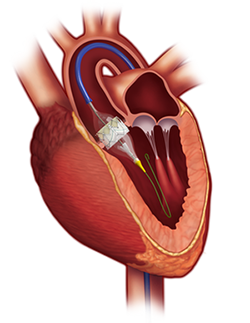Aortic Valve Disease
Aortic Valve Stenosis
Aortic valve stenosis occurs when the opening of the aortic valve becomes narrowed and the valve no longer opens fully with each heartbeat. The aortic valve is located between the left ventricle of the heart and the aorta, the largest artery in the body. Aortic stenosis becomes increasingly common with age, predominantly affecting those over the age of 65. When symptoms, such as shortness of breath or chest pain, develop from aortic stenosis, the average life expectancy is only 1-2 years, with a prognosis that is worse than most cancers, if left untreated. Unfortunately, at least 1/3 of patients with aortic valve stenosis today are not receiving valve replacement, which is the only treatment that is effective for this condition. This is because many patients who have severe aortic valve stenosis might be too frail or too ill for conventional open-heart surgery, or patients attribute their symptoms to the aging process.

Transcatheter Aortic Valve Replacement (TAVR)
Transcatheter aortic valve replacement (TAVR) is an alternate treatment option to conventional open heart surgery, and TAVR has shown to have equal, and sometimes better outcomes than traditional surgery. TAVR is now an option for patients in all risk categories including inoperable, high, intermediate, and low surgical risk. Some patients prefer a minimalist approach to valve replacement, compared to more invasive surgery. Severe symptomatic aortic stenosis is a life threatening condition. With TAVR, physicians now have the ability to provide aortic valve replacement via minimally-invasive approaches, including percutaneous procedures (intervention without an incision), which provide outcomes that are as good, or sometimes better than, surgical valve replacement. Instead of opening the chest to reach the heart, the physicians use small tubes, or catheters, to thread very small surgical tools to reach the heart.

See Figure 1 and Figure 2. TAVR is a Transcatheter Aortic Valve Replacement that is less invasive than standard valve replacement and allows for quicker recovery time as well.
Our heart team within the TAVR program is multidisciplinary. Patients benefit greatly when they can be evaluated by a multidisciplinary team, who then together decide on the best treatment option and provide the highest level of care. Patients are seen in our Heart Valve Clinic by interventional cardiologists, cardiothoracic surgeons, a structural heart disease fellow, nurse practitioners, physician assistants and nurse coordinators in order to provide seamless, convenient, and comprehensive care. Patients are then reviewed at a weekly multidisciplinary team meeting to finalize treatment plans with input from the referring and/or primary care physician. By pooling knowledge, expertise, and resources, all options are evaluated, allowing the physicians in the UNC Valve Clinic to provide the best patient care.
Watch our YouTube videos about TAVR procedures at UNC.
- NC Health Care Physicians talk about TAVR, a new treatment for aortic valve disease
- Transcatheter Aortic Valve Replacement (TAVR) at UNC Heart & Vascular: All at One Location
- Transcatheter Aortic Valve Replacement (TAVR) Team Approach at UNC Health Care
- UNC’s 100th TAVR Patient Story

Figure 2. Copyright Medtronic 2016.
More Information:
- Edwards LifeSciences NewHeartValve.com
- CoreValve Heart Valve
- The Role of TAVR in Treating Aortic Stenosis
UNC Cardiothoracic Surgery
When traditional open heart surgery is needed for your aortic valve, you want a team of surgeons who offer the highest level of care and the most treatment options. There are many decisions that need to be made (repair vs. replacement; mechanical valve vs. tissue valve). Our team of surgeons provides all treatment options and will work with you to find the option that best meets your needs.